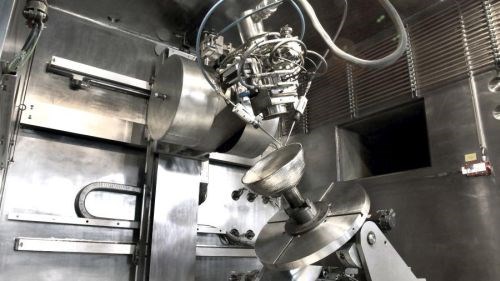Freedom in Electron Beam Additive Manufacturing
The wire-fed EBAM process offers flexibility in part geometry and size—as well as material properties.
Share






Sciaky’s EBAM system is equipped with two wire feeders that travel with the electron beam head, enabling the building of large parts.
Electron Beam Additive Manufacturing (EBAM) holds plenty of possibilities for metal AM applications. The process builds parts using an electron beam to melt metal wire that travels with the beam head. In contrast to powder bed systems in which the size of the part is limited by the size of the bed, parts built on an EBAM system can be as large as the machine’s travels permit.
This capacity for building large parts plus its speed gives EBAM clear potential as an alternative to forging. Like forging, it is a near-net-shape process capable of building large forms. But unlike forging, it requires no die or other tooling, making it faster and more flexible. EBAM can provide design freedoms in geometry that forging cannot.
But perhaps more significantly, EBAM also provides material freedom. Chicago-based Sciaky has developed an EBAM system that allows for two different wires to be fed into the machine. This dual-fed system could be used to deposit two spools of wire simultaneously, increasing throughput, or loaded with both large-diameter and fine wire to provide a range of detail. However, its greatest potential may lie in the ability to blend wires of two different alloys within the same build, creating a proprietary alloy or even a gradient between materials.
Read more about and with this technology on Additive Manufacturing magazine’s website.
Related Content
-
The Downloadable Metal 3D Printer
Copenhagen researchers introduce a fully open-source laser powder bed fusion system, now available on GitHub. This release follows their development of an open-source vat polymerization machine. Here is the purpose and promise of this philanthropically funded effort to advance additive manufacturing application and adoption.
-
Machine Tool Drawbar Made With Additive Manufacturing Saves DMG MORI 90% Lead Time and 67% CO2 Emission
A new production process for the multimetal drawbar replaces an outsourced plating step with directed energy deposition, performing this DED along with roughing, finishing and grinding on a single machine.
-
Designing a 3D Printed Part with Machining in Mind
Designing extra stock and mounting features into a 3D printed part can aid in machining processes downstream.
.jpg;width=70;height=70;mode=crop)













